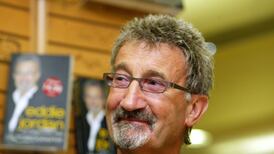John Burke:The sculptor John Burke, who has died aged 60, was best known for his large-scale steel sculptures, and was highly regarded as a creator and maker of public art. His early work used found objects such as farm machinery.
This soon developed into sculpture that evolved directly from raw sheet-steel, juxtaposing simple geometric shapes in the abstract formalist tradition. He generally painted his sculptures with one colour to soften the often violent angularism.
He was a strong advocate of craft as opposed to theory as a means to produce art. He considered a sound working knowledge of material and technique to be an essential tool that had to be rigorously adhered to in the pursuit of fluent creativity.
Mary Cloake, director of the Arts Council, last week said, "John Burke was a skilled and innovative sculptor who brought life and beauty to his work." As a founder member of Aosdána, she said, "he was instrumental in creating the structures that have served artists so well in the intervening years and was also a gifted and dedicated teacher".
The critic Hilary Pyle in 1973 wrote, "Just as a sense of space is an essential component of his art, on whatever scale he works, a feeling of ease and fluidity is common to all of John Burke's sculpture. Every image is in constant movement."
Born in Clonmel, Co Tipperary, in 1946, he took night classes in drawing and painting as a schoolboy. He began attending the Crawford School of Art, Cork, in 1964, but soon found himself disillusioned with the quality of education on offer. He complained of "remoteness, lack of courses".
He was drawn to sculpture, attending night classes at technical school to learn welding, and began working with scrap metal.
He was influenced by the cubists and by British and American sculptors, in particular by David Smith.
After three years studying - mostly on his own - in Cork, he won the Macaulay Fellowship and went to London. There he worked in the studio of the Manx-born sculptor, Bryan Kneale, for three days a week.
He spent another two days in the life-drawing room at the Royal Academy.
He then travelled for a year, in North Africa and the Greek Islands, and returned to Ireland by way of Italy and Holland - completing a journey that retraced much of the history of western art.
He set up a studio and workshop in a converted stable in Blarney, near Cork city. Living in a mobile home, he supported himself by teaching two days a week at the Crawford School of Art. There he was an acknowledged influence on such artists as Éilis O'Connell, Vivienne Roche, Maud Cotter, James Scanlon and John Gibbons. He ceased teaching in the late 1970s in order to work full-time as a sculptor.
His work was shown in the Irish Exhibition of Living Art, as well as at international events such as Artists 77, New York (1977); 18 European Sculptors, Munich (1978); Sculpture Européene, Brussels (1979); A Sense of Ireland, London (1980); and CAN, Cork (1985), where he won the sculpture prize.
Known for his strongly individualistic nature, he asked to be buried in a standing position on a height in Co Cork but within view of his native Co Tipperary. Accordingly, he was buried in a standing position at Árd na Gaoithe cemetery, Watergrasshill, with a view of the Knockmealdowns and the Galtee mountains.
His daughter Eve survives him.
John Burke: born 1946; died December 11th, 2006








